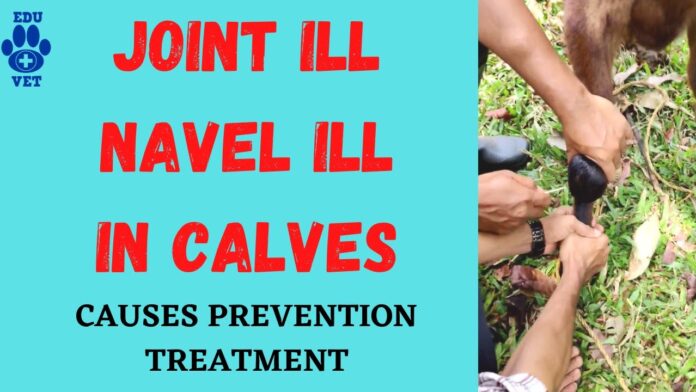JOINT ILL OR NAVEL ILL IN CALVES: SIGNS- PREVENTION AND ITS TREATMENT
Dr. Dharmendra kumar 1 , Dr. Priya Singh 2, Dr. Neelam tandia2, Dr. Swatantra Singh2,Dr. PDS Raghuvansi 1, Dr. Deepak Ningwal2, Dr. Shilpa Gajhbhiye2, Dr. Mudasir Ahmed shah 3, Dr. Bhawana Kushwaha 4
1 Associate Professor, 2 Assistant Professor, Department of Surgery and Radiology,College of Veterinary Science and Animal Husbandry, NDVSU, Rewa (MP)-486001.
3 Veterinary officer, Department of Animal husbandry, Kashmir
4 Veterinary officer, Department of Animal husbandry, Madhya Pradesh
Bacterial infections via the umbilicus (navel) are much higher when calves are born in a dirty calving environment. These infections can be prevented by adequate navel treatment in calves and adequate passive antibody transfer (three litres of good quality colostrum during the first 6 hours of life but preferably within the first two hours). Navel infection may remain localised to the navel but can also lead to peritonitis and in more severe cases to septicaemia and focal infections such as joint ill and meningitis. In most cases of joint ill and septicaemia, bacteria gain entry through the gut within the first few hours of life before colostrum ingestion rather than from umbilical infection.
Clinical signs-
The umbilicus is typically hot, painful, and moist. The calf is dull and reluctant to suck and may stand with an arched back. It is essential to determine whether the bacterial infection has spread further into the peritoneal cavity, liver and bloodstream with possible localisation in joints and the brain. In older calves the umbilical infection may be limited to an abscess at the navel. Spread of infection from the umbilicus into the peritoneal cavity leading to septic peritonitis causes rapid deterioration in the calf’s condition, abdominal distension caused by gut stasis, and death within 2-3 days.
Diagnosis-
Diagnosis is based upon a thorough clinical examination taking care to check for other focal bacterial infections. Ultrasonography is useful to investigate involvement of the umbilical vessels and urachus, and to differentiate a hernia from an umbilical abscess.
Treatment-
Penicillin for 5-7 days remains the antibiotic of choice for umbilical infections. Other antibiotics may be prescribed by a veterinary surgeon for calves with meningitis and polyarthritis following septicaemia. Umbilical abscesses can be lanced after needle aspirate or ultrasonography, then flushed daily for three to five days. But the prognosis is hopeless for those calves with significant peritoneal infection.
Prevention/control measures-
- Maintain strict hygiene in the calving environment.
- Treat the umbilical remnant at birth, and 2-4 hours later with iodine where possible.
- Ensure adequate and timely colostrum ingestion (three litres of good quality colostrum during the first 6 hours of life but preferably within the first two hours).
JOINT ILL (INFECTIOUS POLYARTHRITIS) –
Localisation of bacteria within joint(s) to cause an infectious arthritis. Bacteria enter the bloodstream from the gut and upper respiratory tract in calves born in poor sanitary conditions with delayed or inadequate colostrum intake. It occurs due to Localisation of bacteria from the bloodstream into joint(s), bacteria enter the bloodstream from the gut and upper respiratory tract. The untreated umbilicus is not a common portal for bacteria. E. coli and Strep. spp are the common isolates from infected joints.
Clinical signs-
The joints most commonly affected are the fetlock, carpal joints, hock, and stifle joints. The affected joint(s) are swollen, hot, and painful. The drainage lymph nodes (prescapular or popliteal) are typically two to four times their normal size. Infection causes considerable muscle wastage over the gluteal/shoulder regions.
- Moderate (4/10) to non-weight-bearing (10/10) lameness.
- Signs from around three to five day-olds.
- Calves with two or more limbs affected adopt a “crab-like” stance.
- Fetlock, knee and hock joints are most commonly affected.
- Rapid muscle atrophy compared to the unaffected leg.
- Rectal temperature is often within the normal range.
- The navel may be thickened and painful.
- The affected joint(s) are swollen, hot, and painful.
- The drainage lymph node is enlarged.
Treatment–
- Antibiotic therapy
- NSAID treatment
- Joint lavage can be undertaken where one joint is affected and the joint is flushed in the early stages of infection.
Prevention and control of navel ill–
- Adequate passive antibody transfer with a minimum of 3 litres of good quality colostrum during the first 6 hours of life but preferably the first two hours.
- An oesophageal feeder can be used to administer colostrum if the calf will not suck.
- Reduce environmental bacterial challenge in calving boxes by cleaning out between each calving cow.
- Umbilicus (navel) must be fully immersed in strong veterinary iodine BP within the first 15 minutes of life and repeated 2 to 4 hours later where possible.
- Treat all infections promptly after seeking veterinary advice.


